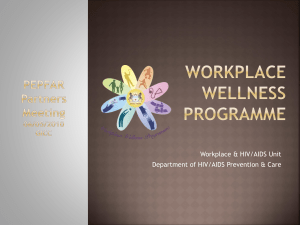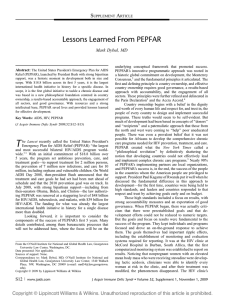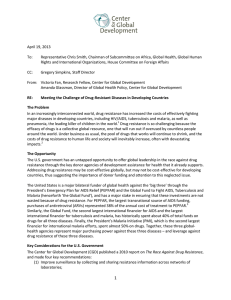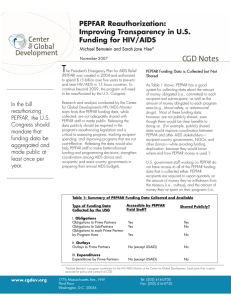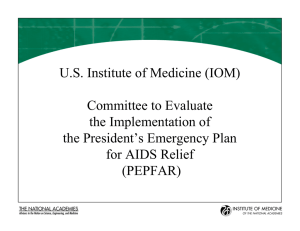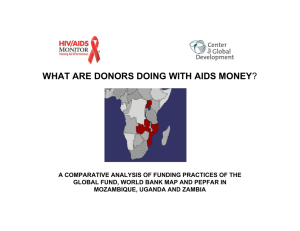Powerpoint
advertisement
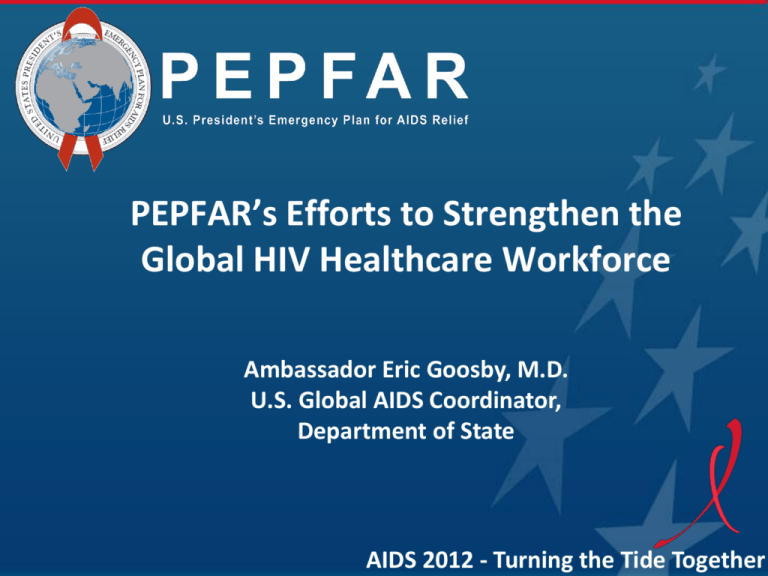
PEPFAR’s Efforts to Strengthen the Global HIV Healthcare Workforce Ambassador Eric Goosby, M.D. U.S. Global AIDS Coordinator, Department of State AIDS 2012 - Turning the Tide Together Healthcare Worker Shortage & HIV Pandemic Health Worker : Population Ratio (World Health Organization, 2006) HIV Prevalence (UNAIDS, 2006) The President’s Emergency Plan for AIDS Relief (PEPFAR) • PEPFAR I: 2003-2008 – Priority: Scaling-up HIV/AIDS treatment, care and prevention – Challenge: Not enough health care workers HIV training – Focus on in-service training to teach HIV skills to existing health workers, task shifting/task sharing HIV services, and some integration of HIV content into pre-service degree programs • Task shifting – “Game changer” in scaling-up HIV treatment, care, and prevention – Support for WHO Task-shifting Guidelines PEPFAR II (2009-2014) • Priority: Health Systems Strengthening – Country ownership and sustainability of HIV programs – Congressional mandate to train and support retention of 140,000 new health care workers, with an emphasis on doctors, nurses, and midwives – The Human Resources for Health 2009 inter-agency technical working group strategy involves: “Strengthening regulatory bodies and professional associations”, including nursing organizations • World AIDS Day 2012 – Recognizing critical role of nurses and midwives to meet new targets: • 6 million on ART • 1.5 million pregnant women on ART • 4.7 million voluntary medical male circumcision PEPFAR’s HRH Strategy: Vision and Goals Vision: Appropriate number and distribution of qualified health workers who meet the HIV and other health needs of the population Goals: • Increase the Density of Health Workforce – Number – Cadres • Balance Distribution of Health Workforce – Geographic location – Sector – Gender • Improve Performance of Health Workforce – Quality – Efficiency Health Labor Market Dynamics Flow Chart Illustrating Various Points for Policy Intervention in HRH Labour Market Health Care Education Labor Force Take-up Rate Participation Rate Health Care Labor Force Participation Rate Health Care Sector High School Training in Health Pool of Qualified HW Employed Unemployed Other Training MIGRATION USA, UK Adapted from Marko Vujicic, World Bank 2009 NonHealth Care Sector Geographic distribution Private/Public sector allocation Absenteeism Skill mix Productivity Quality PEPFAR’s Human Resources for Health Objectives 1. Strengthen pre-service education institutions 2. Ensure quality of in-service and pre-service training and practicing professionals 3. Support the development of new cadres and strengthen the community workforce 4. Improve health worker motivation and productivity and foster positive workplace environments 5. Investigate and apply recruitment and retention strategies 6. Improve HRIS and utilization of data for improved management and planning Objective 1 Strengthen pre-service education institutions New HCW Students Teachers and Effective Leadership Infrastructure Source: ITECH Objective 2 Ensure quality of inservice and pre-service training and practicing professionals • MEPI/NEPI • East Africa: multi-country learning collaborative to strengthen regulatory bodies and professional associations • Uganda & Tanzania: Evaluating country in-service HIV/AIDS training programs • Global: twinning partnerships in ten countries in Africa and Russia. Health Workforce Initiatives • PEPFAR’s medical and nursing pre-service training initiatives: – Competitive awards to African institutions (MEPI) – Grants to specific countries to identify and support priority interventions to nursing institutions (NEPI) – Transformative Guidelines (WHO) and related activities • Objectives of initiative – – – – – – Workforce capacity - numbers and quality Education and training more relevant to country needs Innovative education models Research capacity (MEPI) Evidence based policies and technical materials Costs of effective strategies Medical and Nursing Education Partnership Initiative • PEPFAR initiative under the direction of the Office of the U.S. Global AIDS Coordinator • PEPFAR Implementing agencies, U.S. Department of Health and Human Services, – Health Resources and Services Administration (HRSA), HIV/AIDS Bureau – National Institutes of Health (NIH), Fogarty Center – Coordinating Centers • George Washington University, Wash DC • Columbia University, NY • Other partners (non-USG): – WHO – Transformative Guidelines – Policy and Technical – CHAI and USAID/Capacity Plus Directory of Awards Medical Education Partnership Initiative (MEPI) and Nurse Education Partnership Initiative (NEPI) • • • • • • • • • • • • • Botswana Ethiopia Ghana Kenya Lesotho (NEPI only) Malawi (MEPI/NEPI) Mozambique Nigeria South Africa Tanzania Uganda Zimbabwe Zambia (MEPI/NEPI) PEPFAR/WHO Collaborative: Transformative Medical Nursing and Midwifery Education Guidelines • Purpose: To support the new political and resource commitments by providing sound policy and technical guidance • Apply to a wide range of providers and promotes the efficient use of providers through task shifting • Promotes innovation: – interdisciplinary teams – Service networks • Supports the decentralization of education and training with consideration to rural programs • Builds on and promotes the use of existing WHO policies Objective 3 Support the development of new cadres and strengthen the community workforce • WHO: Task-shifting guidelines • Mozambique & South Africa: Development of new cadres • GHWA: Community Health Workers study • Global: Community Health Worker Program Assessment and Improvement Matrix (CHW AIM) African Health Profession Regulatory Collaborative (ARC) • Four-year initiative to strengthen nursing and midwifery leadership and regulation in 17 sub-Saharan African countries • Objectives – – – – Ensure high quality practice standards Ensure updated regulatory frameworks Strengthen nursing and midwifery councils Cultivate African nursing leadership • Approach – – – – – Regional conferences South-to-south collaboration Regulation improvement grants Targeted technical assistance Evaluation science Objective 4 Improve health worker motivation and productivity and foster positive workplace environments Figure 1. Uganda Productivity: Average Client Waiting Times in Kabuyanda Baseline and Follow-up Average Client Waiting Times in Kabuyanda at Baseline and Follow-up Average waiting time at baseline Average waiting time at follow-up 198 200 180 160 Average time (minutes) • Zanzibar & Tanzania: Productivity & Work Climate Study • Niger, Uganda, & Tanzania: HRH Collaboratives • Swaziland & Uganda: Wellness Centers for health workers • Rwanda : national performance based incentive scheme 143 140 120 100 80 61 60 40 48 26 31 20 29 7 0 Registration & triage Consultation Dispensing TOTAL Clinic service * The average waiting time for 'Consultation' at follow-up is a weighted average of 'Consultation with nurse' and 'Consultation with clinician' Objective 5 Investigate and apply recruitment and retention strategies • WHO: Retention recommendations for increasing access to health workers in remote and rural areas • Mozambique & Swaziland: Retention & Quality of Services study • Tanzania: Recruiting health students from rural areas • Global: Developing recommendations for measuring retention in PEPFAR countries Objective 6 Improve HRIS and utilization of data for improved management and planning • Global: Implementing iHRIS (open source software) in 14 countries • Kenya: Public Health HR Information System and Workshop being expanded for use in other countries • Uganda: Work with MOH & MOF on resource planning • Global: HRM Rapid Assessment Tool & Curricula development From: “Zeroing In: AIDS Donors and Africa’s Health Workforce” – Oomman, Wendt, Droggitis. Center for Global Development. August 2010 Expanding the Evidence Base: Research & Innovation • Tools – – – – HRH Action Framework (http://www.capacityproject.org/framework/) Rapid Discrete Choice Experiment (DCE) Tool Employee Engagement Tool TrainSMART • Implementation Science – – – – Impact of task-shifting on ART delivery (multi-country) Effectiveness and attrition of providers in PEPFAR-funded health centers (Ethiopia) Study on Success Factors for Management Capacity Building Sustainability Impact of Task Shifting for ART Delivery on Patient and Process Outcomes in Uganda – Nurse-initiated and managed HIV Treatment in Policy, Education, and Practice in 17 African countries – Measuring the Impact of On-Site Mentorship on Nurse and Clinical Officer’s HIV and TB Care and Competencies – Descriptive Study of Nursing and Midwifery Practice and Education Regulation in East, Central, and Southern Africa Considerations Going Forward • An appropriate balance between ‘quantity and quality’. • Multi-sectoral approaches, particularly between health and education sectors • Long term, sustainable changes in areas of recruitment, education/training, and retention. • The use of evidence-based information with demonstrated effectiveness in LMIC. • Affordable in LMIC. Thank You For further information, please visit: www.PEPFAR.gov www.facebook.com/PEPFAR http://twitter.com/USPEPFAR
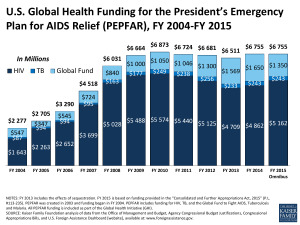



![Africa on the rise - Health[e]Foundation](http://s2.studylib.net/store/data/005761249_1-4e2609b64b2c374f99ff6e9dbe45edb8-300x300.png)

